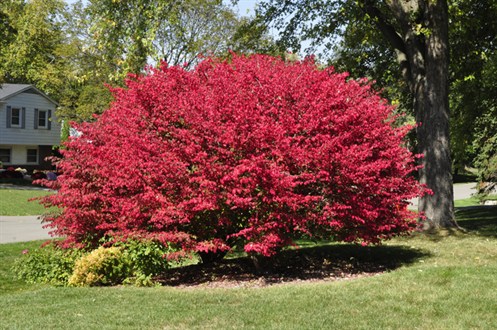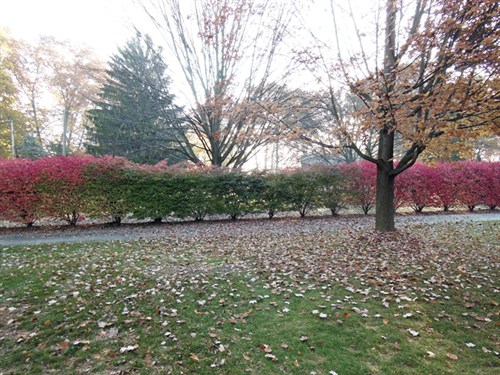Vital statistics
Full sun and well drained soil are all it asks to grow and color
well. It tolerates almost every condition except poor drainage,
which stunts it, causes premature, poor fall color, and eventually
kills it.
The full sized burning bush (Euonymus alatus) is often
mistaken for a small tree (15-20' tall). Dwarf burning bush is
smaller than its parent species yet still surprises most people
since it can reach 8-12'.
Below: The dwarf (left) and full-size or "standard" burning
bush natural forms. Neither of these plants has been pruned.
(Scroll to see larger images.)


This species has been one of the mainstays of the North American
landscape for 100 years, yet it is now recognized as invasive in
some situations -- spreading by seed into wild areas, to the
detriment of native plants whose space and resources it usurps. So
if you do not find it for sale, chances are that your State or
Province has outlawed its sale.
Fall color
Burning bush or winged euonymus is known for its bright red
color. It stars in the middle of the fall color procession.
The full sized burning bush (Euonymus alatus) is
usually pink in fall, or a paler red than the dwarf selections. Its
twigs also have larger "wings" (corky ribs).
Too much shade can dull this plant's color show. Too much
protection can keep it green right until the cold kills its leaves,
which drop off green. The plant needs lenthening nights and fall's
big temperature shifts at sundown to color well, so its show may
fail if it's too well sheltered, such as under overhanging
eaves or surrounded by heat-retaining walls of a courtyard


Below: The development of color can be delayed or subdued by
shade, proximity to a heat sink such as a brick wall, or protection
from cold snaps at sunset (such as may be provided by overhanging
tree limbs or a building's eaves). Sometimes a burning bush is so
protected that it does not turn color at all but finally loses its
leaves to severe cold when they are still green. The shaded,
protected section of the dwarf burning bush hedge pictured below
eventually develops red color if the fall is a long one; if heavy
frosts come early that portion of the hedge remains green.
